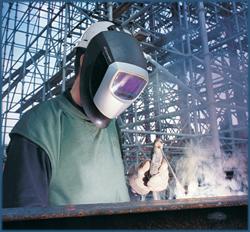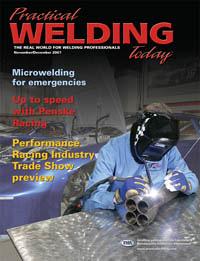- FMA
- The Fabricator
- FABTECH
- Canadian Metalworking
Categories
- Additive Manufacturing
- Aluminum Welding
- Arc Welding
- Assembly and Joining
- Automation and Robotics
- Bending and Forming
- Consumables
- Cutting and Weld Prep
- Electric Vehicles
- En Español
- Finishing
- Hydroforming
- Laser Cutting
- Laser Welding
- Machining
- Manufacturing Software
- Materials Handling
- Metals/Materials
- Oxyfuel Cutting
- Plasma Cutting
- Power Tools
- Punching and Other Holemaking
- Roll Forming
- Safety
- Sawing
- Shearing
- Shop Management
- Testing and Measuring
- Tube and Pipe Fabrication
- Tube and Pipe Production
- Waterjet Cutting
Industry Directory
Webcasts
Podcasts
FAB 40
Advertise
Subscribe
Account Login
Search
Revisions to respiratory protection
Answering 6 common questions can help in selecting the right respirator
- By Shannon DeCamp
- November 6, 2007
- Article
- Safety
The Occupational Safety and Health Administration (OSHA) recently made some changes to its Respiratory Protection Standard 1910.134. It now includes a table listing the assigned protection factors for all types of respirators. Now is the time for employers and fabricators alike to review respirator programs (or determine if they need one) to ensure that everyone in the workplace is properly protected.
The two types of respirators are air-purifying respirators and supplied-air respirators. Air-purifying respirators filter the air from the immediate work area before it enters the lungs. Supplied-air respirators provide clean air from an air line or tank. Each type comes in several styles, such as those that cover half of the face (mouth and nose area), all of the face (referred to as a full face piece), or a helmet or hood. Respirator selection becomes particularly important with air-purifying, or filtering, respirators because the respirator is cleaning the air rather than receiving supplied fresh air.
Answering six frequently asked questions can help employers simplify the respirator selection process.
1. How Do Respirator Filters Work?
Air-purifying respirators work by filtering the air before it reaches the lungs. The pores of the filter are small enough to screen out dust and particles. For chemical fumes and gases, the filter contains absorbents such as charcoal that capture the chemicals before they reach the lungs. Some work situations, such as spray painting, require both dust and chemical removal. Most welding applications generate metal fumes or particulate and require filtering to clean the air.
2. What Factors Determine Which Respirator to Use?
To help determine what respirator to use and how long it lasts, OSHA and the National Institute for Occupational Safety and Health (NIOSH) have developed a rating system for respirators called the assigned protection factor (APF). Another new term—maximum use concentration (MUC)—has also been incorporated into the revised OSHA standard.
3. What Are Assigned Protection Factors (APFs)?
APFs are numbers that indicate the level of workplace respiratory protection that a respirator, or class of respirators, is expected to provide to the user. APFs are used to select the appropriate type of respirator based on the permissible exposure limit (PEL) of a contaminant and the level of the contaminant in the workplace. The APF number is the percentage of the contaminant that will be filtered out of the surrounding air.
4. What Are Maximum Use Concentrations (MUCs)?
The selected respirator must keep exposure at or below the PEL. For each specific respirator, the MUC is the largest concentration of an airborne contaminant that the respirator can handle. The exposure level must be measured using OSHA protocol and compared to the MUC for the respirator selected. If the workplace exposure exceeds the respirator's MUC, a respirator with a higher APF must be chosen.
5. What Do These Revisions Mean to the Metal Fabricating Industry?
Fabricators may be required to use a respirator to protect themselves from inhaling fumes, particles, or dust when cutting, grinding, welding, coating, and painting. If work is done with stainless steel or with coatings containing chrome, there is the risk of exposure to hexavalent chromium, and a respirator may be required. It is important to determine the level of exposure for each chemical produced or used in the workplace, and then ensure that the protection level of every respirator is adequate for the exposure level.
6. What Constitutes an Effective Respirator Program?
First, all airborne hazards in the workplace must be identified and their levels determined. These levels must be compared to the OSHA PELs.
Whenever possible, general or local welding or other exhaust systems should be used to control dusts, vapors, gases, fumes, smoke, solvents, and mists that may be generated. Hazardous materials should be used only in designated work areas that can be ventilated.

Determining the type of respirator needed, whether it is a supplied-air unit or an air-purifying unit like the one shown above, depends on the APF it is assigned. Photo courtesy of 3M
If airborne contaminants are still above safe levels after ventilation and exhaust systems have been applied, fabricators must then use respirators to reduce exposure to an acceptable level. Respirators must be approved for each chemical and specific application by NIOSH. Matching the MUC against the measured airborne contaminants ensures selection of a respirator with adequate protection.
Employers should develop written standard operating procedures for the selection and use of respirators. These procedures include when respirators must be worn and who, specifically, must wear them. Welders required to wear a respirator first must have a medical evaluation to be sure that they can safely breathe through the restricted airflow of the respirator.
Once the doctor determines that a welder is medically fit to wear a respirator, fit-testing must be performed to ensure that the respirator fits the shape and size of the face, thereby ensuring a good seal. OSHA regulations list specific protocol for fit-testing.
Everyone must be trained on the correct use and limitations of their respirators. Respirators must be stored in a convenient and clean location, away from contaminants, and must be regularly inspected and sanitized.
About the Author
Shannon DeCamp
140 Wooster Pike
Milford, OH 45150
513-248-0028
About the Publication
subscribe now

The Welder, formerly known as Practical Welding Today, is a showcase of the real people who make the products we use and work with every day. This magazine has served the welding community in North America well for more than 20 years.
start your free subscription- Stay connected from anywhere

Easily access valuable industry resources now with full access to the digital edition of The Fabricator.

Easily access valuable industry resources now with full access to the digital edition of The Welder.

Easily access valuable industry resources now with full access to the digital edition of The Tube and Pipe Journal.
- Podcasting
- Podcast:
- The Fabricator Podcast
- Published:
- 04/16/2024
- Running Time:
- 63:29
In this episode of The Fabricator Podcast, Caleb Chamberlain, co-founder and CEO of OSH Cut, discusses his company’s...
- Trending Articles
Sheffield Forgemasters makes global leap in welding technology

Welding student from Utah to represent the U.S. at WorldSkills 2024

Lincoln Electric announces executive appointments

Lincoln Electric acquires RedViking

Engine-driven welding machines include integrated air compressors

- Industry Events
16th Annual Safety Conference
- April 30 - May 1, 2024
- Elgin,
Pipe and Tube Conference
- May 21 - 22, 2024
- Omaha, NE
World-Class Roll Forming Workshop
- June 5 - 6, 2024
- Louisville, KY
Advanced Laser Application Workshop
- June 25 - 27, 2024
- Novi, MI



























